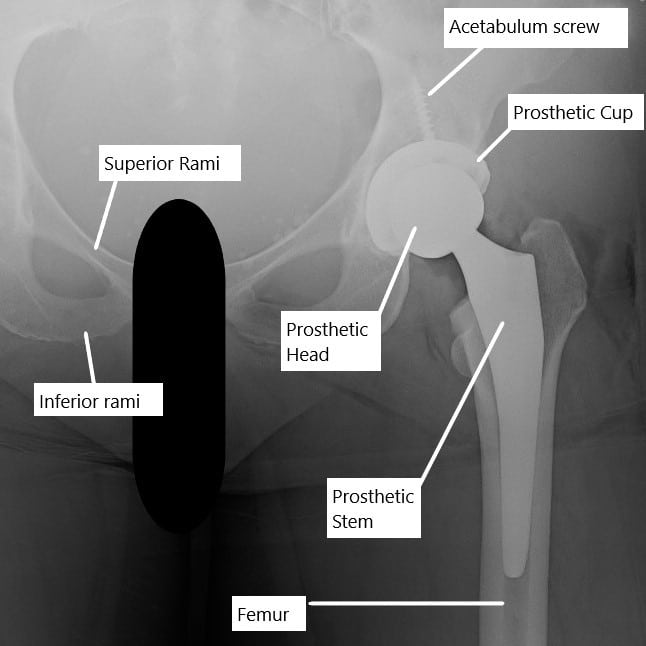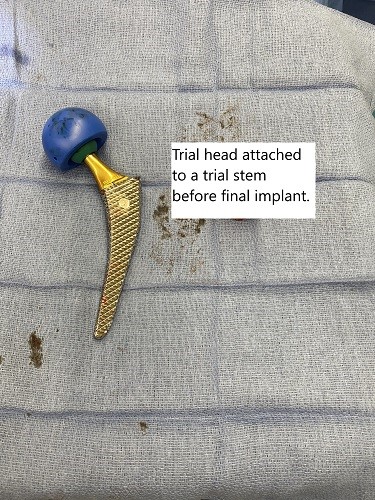Pain after Hip Replacement
Total hip replacement is one of the most successful surgeries in modern medicine. The surgery helps to relieve hip pain associated with arthritis. The patients are able to get back to their daily activities without the fear of pain. Some patients may however complain of pain in the hip region after a total hip replacement. The pain may be associated with the surgery or its complications or may be unrelated to the surgery.
The pain related to total hip replacement may be a result of bone loss, implant selection, implant placement, residual cement, size of implant, nerve or muscle damage. However in a number of cases, the pain may be unrelated to the hip replacement surgery and may be referred to the hip area.

X-ray showing a total hip replacement.
Pain after hip replacement surgery is evaluated extensively by the physician to diagnose the cause of the pain. The physician performs a thorough physical examination which may be followed by blood investigations and radiological studies such as an X-Ray, CT scan or an MRI.
Hip pain with abnormal X-ray studies
- Loosening of the implant without any sign of infection is known as aseptic loosening. The high grade polyethylene cup of the socket may release microscopic debris following motion. The micromotion of the implant also leads to debris accumulation.Special cells in the blood known as macrophages, try to clear the debris but in turn lead the body to attack the debris material with various enzymes and proteins.
This in turn results in inflammation and loss of bone around the implant. The loss of bone surrounding the implant may lead to loosening of the implant.
The loosening is visible on an X-Ray as a clear space around the implant. The implant may further sink in the femoral canal. Patients typically complain of pain after a relative painless period after the surgery.
There are no signs of infection and the pain is worse on movement and weight bearing. At times, patients may complain of rest pain as well.
- Septic loosening is the loosening of the implant secondary to the infection. Infected hip replacement may lead to erosion of the bone around the implant.The erosion and loss of bone is due to various chemicals released by the infecting agent (usually a bacteria) and as a result of the body’s immune system trying to fight the infection. There may be formation of tracts which may open in the skin, leading to discharge of pus.
Patients may have a rise of temperature, swelling and redness of the hip area. Some patients may have a low grade fever. The patient complains of pain which is characteristically worse at night or rest. The pain may occur immediately following the surgery or after weeks, months or years after the surgery.
- Abnormal formation of bone in the tissues surrounding the implant such as muscles is known as heterotrophic ossification. Heterotrophic ossification is visible as bone tissue in the muscles surrounding the hip joint. Patients complain of pain after a relative pain free period after the surgery. The pain is worse with activity and gets better with rest.
- Thigh pain may occur as a result of stress shielding of the femoral stem. The stiff femoral stem may impinge upon the weak bone especially further down the thigh bone.The stress of the femoral stem may lead to thickening of the bone down the thigh bone. Stress shielding occurs due to mismatch of the forces acting at the end of the femoral stem. Patients usually complain of thigh pain rather than hip or groin pain.
- Osteolysis is the loss of bone surrounding the implant but without any loosening. The loss of bone around the implant may lead to pain in the hip region.
- Wrong sized implant and improper positioning of the implant may lead to instability and reduced motion about the hip. The patients often complain of hip pain which may be present in the groin, buttocks or the side of the hip.

Intraoperative image of total hip replacement.
Hip pain with normal X-ray studies
- Iliopsoas tendinitis occurs due to the impingement of the iliopsoas tendon as it crosses the hip joint in the front. Patients complain of hip pain in the groin area and may walk with a limp secondary to pain.The pain characteristically appears after initiation of walking. The iliopsoas muscle helps in the bending of the hip. The pain therefore worsens on bending (flexion) of the hip.
The impingement may occur as a result of malposition of the prosthetic acetabular cup (socket). The impingement may also occur as a result of retained cement particles during the surgery. A numbing injection in the tendon may be used for diagnosing iliopsoas tendinitis.
- Reactive synovitis may cause hip pain after hip replacement. Synovitis may occur as a result of osteolysis or may occur in the absence of osteolysis. The reactive synovitis may be diagnosed with the help of an MRI.
- Damage to the muscle groups during the surgery may lead to postoperative dysfunction and hip pain. The abductor muscles may be damaged during the surgery and may lead to limping and associated pain.
- Bursitis of the trochanteric bursae may lead to characteric pain over the side of the hip. The pain may be associated with pins and needles sensation. The bursae are small sacs containing fluid that help the smooth passing of the tendon and muscles over bony prominences.
- Improper position and uncovered prosthesis during the surgery may lead to impingement of the prosthetic implant. The pain is worse with activity and may get better with rest.
- Damage to the nerves surrounding the hip joint such as the sciatic nerve, superior gluteal nerve, femoral and obturator nerve may lead to pain following the surgery.The risk of damage to a particular nerve depends upon the approach used during the surgery and the technique of the surgery. The symptoms of nerve damage may not be immediate in patients in whom a blood collection in the area surrounding the nerve causes damage.
- Lumbar spine pathologies such as lumbar canal stenosis, prolapsed intervertebral disc and facet joint disease, etc may cause radiating pain to the hip region. Through evaluation and history may help to differentiate the radiating spine pain from hip pain.
- Rarely, pain may be referred to the hip region from a disease process in the abdomen or due to inguinal hernia.
Conclusion
Hip pain after hip replacement may occur due to the wide variety of causes. A physician may be able to diagnose the cause of the pain and help direct appropriate treatment for it’s resolution. In very rare circumstances, the cause of hip pain may remain illusive. Regardless, the incidence of hip pain after hip replacement is not that common and surgery is one of the most successful among all other surgeries performed by orthopedic surgeons.
Do you have more questions?
Are there specific exercises or rehabilitation techniques that can target and alleviate pain after hip replacement surgery?
Yes, physical therapists can prescribe a variety of exercises and rehabilitation techniques tailored to each patient’s needs and goals. These may include gentle stretching, strengthening exercises, balance training, gait training, and functional activities to help reduce pain and improve hip function.
Can certain lifestyle modifications help in managing pain after hip replacement surgery?
Yes, adopting certain lifestyle modifications such as maintaining a healthy weight, avoiding activities that put excessive stress on the hip joint, using assistive devices as needed, practicing good posture, and following proper body mechanics can help in managing pain and promoting long-term joint health after hip replacement surgery.
How important is it to adhere to post-operative instructions and precautions to minimize pain and complications?
Adhering to post-operative instructions and precautions provided by the surgeon and healthcare team is crucial for minimizing pain, preventing complications, and promoting successful outcomes after hip replacement surgery. These instructions often include activity restrictions, medication management, wound care, and follow-up appointments.
Is it normal to experience psychological distress or emotional reactions such as anxiety or depression due to pain after hip replacement surgery?
Yes, it is not uncommon for patients to experience psychological distress or emotional reactions such as anxiety, depression, frustration, or fear due to pain or challenges during the recovery process after hip replacement surgery. Seeking support from healthcare professionals, family members, or mental health professionals can be helpful in addressing these concerns.
How can I effectively communicate my pain levels and concerns to my healthcare provider after hip replacement surgery?
Effective communication with your healthcare provider is essential for addressing pain and concerns after hip replacement surgery. Keep a pain diary, be specific about your symptoms, ask questions, express your preferences and goals for pain management, and actively participate in shared decision-making regarding treatment options.
Are there any alternative or complementary therapies that may help in managing pain after hip replacement surgery?
Yes, alternative or complementary therapies such as acupuncture, massage therapy, heat or cold therapy, relaxation techniques, guided imagery, or dietary supplements may provide additional relief from pain and support overall well-being after hip replacement surgery. However, it’s essential to discuss these options with your healthcare provider before trying them.
What are the potential long-term effects or complications of persistent pain after hip replacement surgery?
Persistent pain after hip replacement surgery may impact a patient’s quality of life, mobility, independence, and ability to perform daily activities. It may also increase the risk of developing chronic pain, functional limitations, joint stiffness, muscle weakness, or psychological issues over time. Early recognition and management of pain are crucial for minimizing long-term effects and complications.
How does the type of hip replacement surgery (e.g., anterior vs. posterior approach) impact post-operative pain and recovery?
The type of hip replacement surgery, such as anterior vs. posterior approach, can affect post-operative pain, recovery time, and outcomes. The anterior approach may result in less muscle damage and faster recovery, potentially leading to reduced post-operative pain compared to the posterior approach. However, individual factors and surgical techniques also play significant roles in determining pain levels and recovery outcomes.
How soon after hip replacement surgery can I start physical therapy to address pain and regain mobility?
Physical therapy typically begins soon after hip replacement surgery, often within the first few days or weeks, depending on the individual’s overall health status and the surgeon’s recommendations.
What role does physical therapy play in managing pain after hip replacement surgery?
Physical therapy is an essential component of rehabilitation after hip replacement surgery, helping to improve strength, flexibility, and mobility while reducing pain and promoting optimal recovery.
Are there any specific warning signs or symptoms that I should watch out for regarding pain after hip replacement surgery?
Yes, warning signs or symptoms to watch out for regarding pain after hip replacement surgery include sudden onset or worsening of pain, pain that does not improve with rest or medication, swelling, warmth, redness, or drainage from the surgical site, fever, chills, or difficulty moving the hip joint.
How can I differentiate between normal post-operative pain and pain that may signal a complication?
Normal post-operative pain typically improves gradually over time and is manageable with pain medications and other conservative measures. However, pain that is severe, worsening, or accompanied by other concerning symptoms such as fever, redness, swelling, or difficulty bearing weight may indicate a complication and requires medical attention.
Should I be concerned if I experience persistent or severe pain after hip replacement surgery?
Persistent or severe pain after hip replacement surgery may indicate underlying issues such as infection, implant loosening, dislocation, nerve damage, or other complications, and should be promptly evaluated by a healthcare provider.
How effective are non-drug therapies such as physical therapy or acupuncture in alleviating post-operative pain?
Non-drug therapies such as physical therapy, acupuncture, or transcutaneous electrical nerve stimulation (TENS) can be effective complementary approaches to pain management after hip replacement surgery, helping to improve mobility, reduce inflammation, and alleviate discomfort.
What medications are commonly prescribed to manage pain after hip replacement surgery?
Pain management medications may include nonsteroidal anti-inflammatory drugs (NSAIDs), acetaminophen, opioids, muscle relaxants, or nerve pain medications, depending on the individual’s needs and tolerance.
Are there specific activities or movements that may exacerbate pain after hip replacement surgery?
Yes, certain activities such as high-impact exercises, heavy lifting, or prolonged periods of standing or walking may exacerbate pain during the recovery period after hip replacement surgery.
How long does it typically take for the pain to subside after hip replacement surgery?
The duration of pain after hip replacement surgery varies among individuals, but it often improves gradually over several weeks to months as the surgical site heals and the body adjusts to the new hip joint.
What are the most common causes of pain after hip replacement surgery?
Pain after hip replacement surgery can result from various factors such as inflammation, nerve irritation, muscle strain, implant-related issues, infection, or complications related to the surgical procedure.

Dr. Suhirad Khokhar
My name is Dr. Suhirad Khokhar, and am an orthopaedic surgeon. I completed my MBBS (Bachelor of Medicine & Bachelor of Surgery) at Govt. Medical College, Patiala, India.
I specialize in musculoskeletal disorders and their management, and have personally approved of and written this content.
My profile page has all of my educational information, work experience, and all the pages on this site that I've contributed to.
